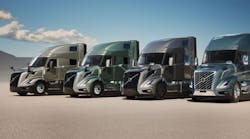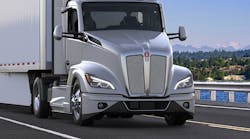Key takeaways:
- Werner Enterprises reduced its capital expenditure forecast by at least $40 million due to uncertainties around tariffs and emissions regulations, now expecting to spend between $145 million and $185 million.
- The company reported a significant profit increase in the second quarter, aided by a favorable legal outcome that allowed for the reversal of a major liability.
- Executives see a stable freight market but are wary of expecting substantial demand improvements, focusing instead on operational enhancements to capitalize on future opportunities.
Werner Enterprises executives have trimmed their planned capital spending for the year by at least $40 million, citing continued broad uncertainty around tariffs and emissions regulations as well as growth of the company’s logistics business.
Leaders of Omaha-based Werner, the No. 11 carrier on the 2025 FleetOwner 500 list of largest for-hire fleets, said this week they now expect to spend a net of $145 million to $185 million on equipment, terminals, and technology this year versus their previous forecast of $185 million to $235 million. That downshift reflects first-half spending of $66 million, which equates to about 4% of revenue—whereas the company’s average from 2022 to 2024 was close to 10% of the top line.
Speaking to analysts and investors after reporting second-quarter earnings July 29, Chairman and CEO Derek Leathers and CFO Chris Wikoff said one reason they can step back from their previous forecast is that Werner started 2025 with a higher-than-normal inventory of new trucks. That, in addition to the various forms of uncertainty emanating from Washington, D.C., spurred the lower spending outlook.
In turn, the lower capex means the average age of a Werner truck is now 2.4 years—a fact that doesn’t bother Leathers, who said his teams have been working on several operational improvements.
“2.4 years doesn’t worry me a whole lot compared to our more recent range that was a little lower,” he said. “We think we’re better positioned and still have the optionality if we can get some things done with some of our OEM partners […] But we feel very good about the utilization in our terminals to do on-site maintenance versus over the road and the ability to expand that even further.”
Still, Werner’s capex cut is the latest in a series from fleet leaders who are not only reacting to policy uncertainty but also to the enduring weak freight market. Despite signs from some corners that demand is strengthening—Werner’s leaders see a stable market these days, but Leathers added that they’re “not banking on big demand improvement, but we do think the supply story will continue to play out”—large fleets have retreated from hundreds of millions of dollars’ worth of spending in recent months. That has led equipment manufacturers to cut production and jobs, pinning some of their hopes on a rebound spurred by tax changes in the One Big Beautiful Bill Act. (See the stories on the right.)
Werner posted a profit of $44.1 million on revenues of $753 million in the second quarter, improving from a year earlier, when earnings were $9.5 million on slightly higher sales. A major contributor to the reversal was the Texas Supreme Court's reversal of a 2018 accident verdict, which meant Werner could reverse a $45.7 million liability still on its books.
Revenues at the company’s truckload division slipped 4% to $518 million while operating income fell by nearly half to $12.8 million, but logistics revenues climbed 6% to $221 million and more than tripled its adjusted operating profits to $5.9 million. Leathers said the company is positioned well to benefit from a rebound in freight activity.
“As the trucking environment shows signs of improving, we’ve got tailwinds forming at a macro level and specific to Werner,” he said.
Shares of Werner (Ticker: WERN) didn’t move much on the heels of executives’ earnings report and conference call. On the afternoon of July 31, they were changing hands at $27.57, down slightly on the day. Over the past six months, they have fallen more than 20%, which has cut the company’s market capitalization to about $1.6 billion.
About the Author
Geert De Lombaerde
Senior Editor
A native of Belgium, Geert De Lombaerde has more than two decades of experience in business journalism. Since 2021, he has written about markets and economic trends for Endeavor Business Media publications FleetOwner, Healthcare Innovation, IndustryWeek, Oil & Gas Journal, and T&D World.
With a degree in journalism from the University of Missouri, he began his reporting career at the Business Courier in Cincinnati. He later was managing editor and editor of the Nashville Business Journal. Most recently, he oversaw the online and print products of the Nashville Post and reported primarily on Middle Tennessee’s finance sector and many of its publicly traded companies.




